2011 Peugeot 308 SW BL Front seats
[x] Cancel search: Front seatsPage 120 of 336

i
118
CHILD SAFETY
PEUGEOT recommends
that chil-
dren should travel in the rear seats
of your vehicle:
- "rearwards-facing"
up to the
age of 2,
- "forwards-facing"
over the
age of 2.
TO CHILD SEATSCHILD SEAT IN THE FRONT
"Forwards-facing"
When a "forwards-facing" child seat is
installed on the front passenger seat
,
adjust the vehicle's seat to the interme-
diate longitudinal position with the seat
back upright and leave the passenger
airbag activated.
"Rearwards-facing"
When a "rearwards-facing" child seat is
installed on the front passenger seat
,
it is essential that the passenger airbag
is deactivated. Otherwise, the child
would risk being seriously injured or
killed if the airbag were to infl ate
.
*
The rules for carrying children are
specifi c to each country. Refer to the
current legislation in your country. Although one of PEUGEOT's main cri-
teria when designing your vehicle, the
safety of your children also depends on
you.
For maximum safety, please observe
the following recommendations:
- in accordance with European
regulations, all children under the
age of 12 or less than one and
a half metres tall must travel in
approved child seats suited to
their weight
, on seats fi tted with a
seat belt or ISOFIX mountings * ,
- statistically, the safest seats in
your vehicle for carrying children
are the rear seats,
- a child weighing less than 9 kg
must travel in the "rearwards-
facing" position both in the front
and in the rear.
Intermediate longitudinal position
Page 122 of 336
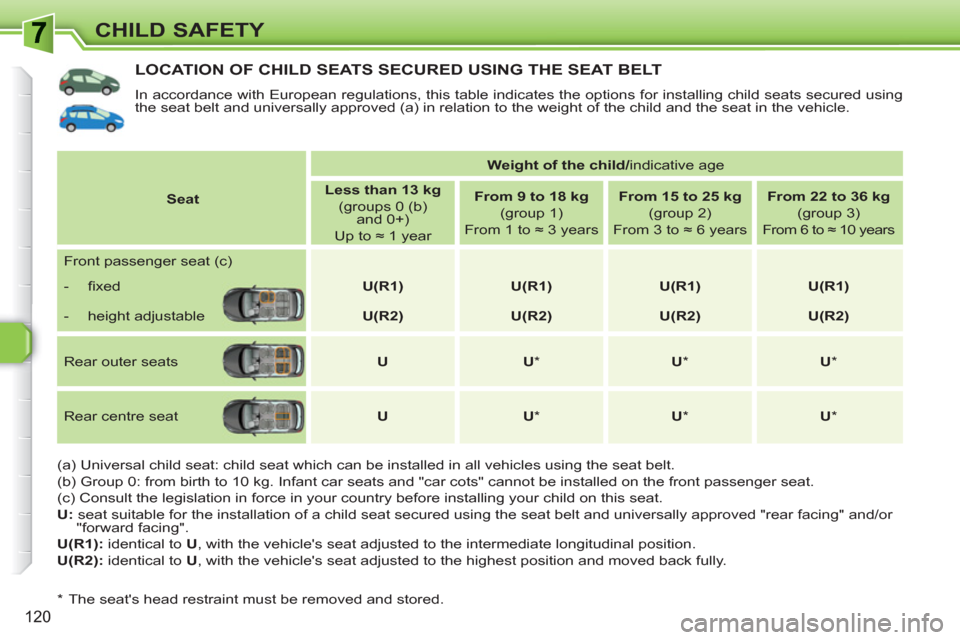
120
CHILD SAFETY
LOCATION OF CHILD SEATS SECURED USING THE SEAT BELT
In accordance with European regulations, this table indicates the options for installing child seats secured using
the seat belt and universally approved (a) in relation to the weight of the child and the seat in the vehicle.
(a) Universal child seat: child seat which can be installed in all vehicles using the seat belt.
(b) Group 0: from birth to 10 kg. Infant car seats and "car cots" cannot be installed on the front passenger seat.
(c) Consult the legislation in force in your country before installing your child on this seat.
U
: seat suitable for the installation of a child seat secured using the seat belt and universally approved "rear facing" and/or
"forward facing".
U(R1)
: identical to U
, with the vehicle's seat adjusted to the intermediate longitudinal position.
U(R2)
: identical to U
, with the vehicle's seat adjusted to the highest position and moved back fully.
*
The seat's head restraint must be removed and stored.
Seat
Weight of the child/
indicative age
Less than 13 kg
(groups 0 (b)
and 0+)
Up to ≈ 1 year
From 9 to 18 kg
(group 1)
From 1 to ≈ 3 years
From 15 to 25 kg
(group 2)
From 3 to ≈ 6 years
From 22 to 36 kg
(group 3)
From 6 to ≈ 10 years
Front passenger seat (c)
- fi xed
U(R1)
U(R1)
U(R1)
U(R1)
- height adjustable
U(R2)
U(R2)
U(R2)
U(R2)
Rear outer seats
U
U
*
U
*
U
*
Rear centre seat
U
U
*
U
*
U
*
Page 123 of 336

121
CHILD SAFETY
LOCATION OF CHILD SEATS SECURED USING THE SEAT BELT
In accordance with the European regulation, this table indicates the options for the installation of child seats
secured using the seat belt and universally approved (a) depending on the weight of the child and the seat in the
vehicle.
(a) Universal child seat: child seat which
can be installed in all vehicles using
the seat belt.
(b) Group 0: from birth to 10 kg. Infant
car seats and "car cots" cannot be
installed on the front passenger
seat.
Seat
Weight of the child
/indicative age
Below 13 kg
(groups 0 (b)
and 0+)
Up to ≈ 1 year
9 to 18 kg
(group 1)
From 1 to ≈ 3 years
15 to 25 kg
(group 2) From 3 to ≈ 6 years
22 to 36 kg
(group 3)
From 6 to ≈ 10 years
1st
row
Front passenger seat (c)
- fi xed
U(R1)
U(R1)
U(R1)
U(R1)
- height adjustable
U(R2)
U(R2)
U(R2)
U(R2)
2nd
row
Outer
Seat in standard position
and moved inwards
U
U
U
U
Centre
Centre seat
U
U
U
U
3rd
row
Outer
Additional seat
U
U
U
U
Outer
2nd row seat
U
U
U
U
(c) Consult the current legislation in
your country before installing your
child on this seat.
U
: seat suitable for the installation of a
child seat secured using the seat belt
and universally approved, "rear fac-
ing" and/or "forwards facing".
U(R1) : identical to U
, with the vehicle's
seat adjusted to the intermediate
longitudinal position.
U(R2)
: identical to U
, with the vehicle's
seat adjusted to its highest posi-
tion and moved back fully.
Page 124 of 336

!
122
CHILD SAFETY
Installing a booster seat
The chest part of the seat belt must
be positioned on the child's shoulder
without touching the neck.
Ensure that the lap part of the seat
belt passes correctly over the child's
thighs.
PEUGEOT recommends the use of
a booster seat which has a back, fi t-
ted with a seat belt guide at shoulder
level.
As a safety precaution, do not leave:
- a child or children alone and
unsupervised in a vehicle,
- a child or an animal in a vehicle
which is exposed to the sun, with
the windows closed,
- the keys within reach of children
inside the vehicle.
To prevent accidental opening of the
doors and rear windows, use the "Child
lock".
Take care not to open the rear windows
by more than one third.
To protect young children from the
rays of the sun, fi t side blinds on the
rear windows.
The incorrect installation of a child
seat in a vehicle compromises the
child's protection in the event of an
accident.
Remember to fasten the seat belts or the
child seat harnesses keeping the slack
relative to the child's body to a minimum,
even for short journeys.
When installing a child seat using the
seat belt, ensure that the seat belt is
tightened correctly on the child seat and
that it secures the child seat fi rmly on the
seat of your vehicle.
For optimum installation of the "forwards-
facing" child seat, ensure that the back of
the child seat is in contact with the back
of the vehicle's seat and that the head re-
straint does not cause any discomfort.
If the head restraint has to be removed,
ensure that it is stored or attached se-
curely to prevent it from being thrown
around the vehicle in the event of sharp
braking. Children under the age of 10 must not
travel in the "forwards-facing" position
on the front passenger seat, unless
the rear seats are already occupied
by other children, cannot be used or
are absent.
Deactivate the passenger airbag
when a "rearwards-facing" child seat
is installed on the front seat.
Otherwise, the child would risk being
seriously injured or killed if the airbag
were to infl ate.
Page 127 of 336
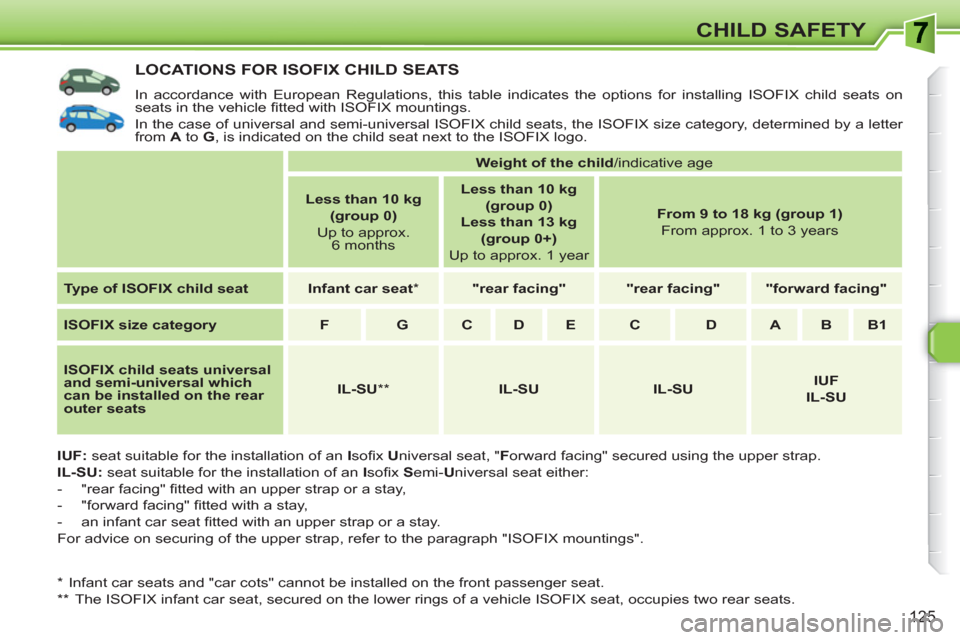
125
CHILD SAFETY
LOCATIONS FOR ISOFIX CHILD SEATS
In accordance with European Regulations, this table indicates the options for installing ISOFIX child seats on
seats in the vehicle fi tted with ISOFIX mountings.
In the case of universal and semi-universal ISOFIX child seats, the ISOFIX size category, determined by a letter
from A
to G
, is indicated on the child seat next to the ISOFIX logo.
IUF:
seat suitable for the installation of an I
sofi x U
niversal seat, " F
orward facing" secured using the upper strap.
IL-SU:
seat suitable for the installation of an I
sofi x S
emi- U
niversal seat either:
- "rear facing" fi tted with an upper strap or a stay,
- "forward facing" fi tted with a stay,
- an infant car seat fi tted with an upper strap or a stay.
For advice on securing of the upper strap, refer to the paragraph "ISOFIX mountings".
*
Infant car seats and "car cots" cannot be installed on the front passenger seat.
**
The ISOFIX infant car seat, secured on the lower rings of a vehicle ISOFIX seat, occupies two rear seats.
Weight of the child
/indicative age
Less than 10 kg
(group 0)
Up to approx.
6 months
Less than 10 kg
(group 0)
Less than 13 kg
(group 0+)
Up to approx. 1 year
From 9 to 18 kg (group 1)
From approx. 1 to 3 years
Type of ISOFIX child seat
Infant car seat
*
"rear facing"
"rear facing"
"forward facing"
ISOFIX size category
F
G
C
D
E
C
D
A
B
B1
ISOFIX child seats universal
and semi-universal which
can be installed on the rear
outer seats
IL-SU
**
IL-SU
IL-SU
IUF
IL-SU
Page 128 of 336
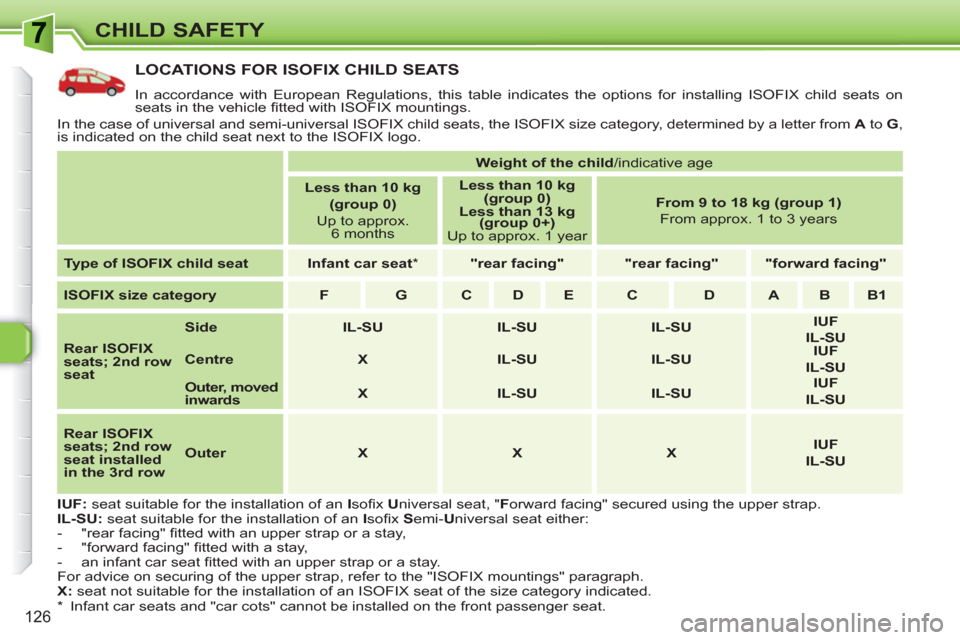
126
CHILD SAFETY
LOCATIONS FOR ISOFIX CHILD SEATS
In accordance with European Regulations, this table indicates the options for installing ISOFIX child seats on
seats in the vehicle fi tted with ISOFIX mountings.
In the case of universal and semi-universal ISOFIX child seats, the ISOFIX size category, determined by a letter from A
to G
,
is indicated on the child seat next to the ISOFIX logo.
IUF:
seat suitable for the installation of an I
sofi x U
niversal seat, " F
orward facing" secured using the upper strap.
IL-SU:
seat suitable for the installation of an I
sofi x S
emi- U
niversal seat either:
- "rear facing" fi tted with an upper strap or a stay,
- "forward facing" fi tted with a stay,
- an infant car seat fi tted with an upper strap or a stay.
For advice on securing of the upper strap, refer to the "ISOFIX mountings" paragraph.
X:
seat not suitable for the installation of an ISOFIX seat of the size category indicated.
Weight of the child
/indicative age
Less than 10 kg
(group 0)
Up to approx.
6 months
Less than 10 kg
(group 0)
Less than 13 kg
(group 0+)
Up to approx. 1 year
From 9 to 18 kg (group 1)
From approx. 1 to 3 years
Type of ISOFIX child seat
Infant car seat
*
"rear facing"
"rear facing"
"forward facing"
ISOFIX size category
F
G
C
D
E
C
D
A
B
B1
Rear ISOFIX
seats; 2nd row
seat
Side
IL-SU
IL-SU
IL-SU
IUF
IL-SU
Centre
X
IL-SU
IL-SU
IUF
IL-SU
Outer, moved
inwards
X
IL-SU
IL-SU
IUF
IL-SU
Rear ISOFIX
seats; 2nd row
seat installed
in the 3rd row
Outer
X
X
X
IUF
IL-SU
*
Infant car seats and "car cots" cannot be installed on the front passenger seat.
Page 134 of 336
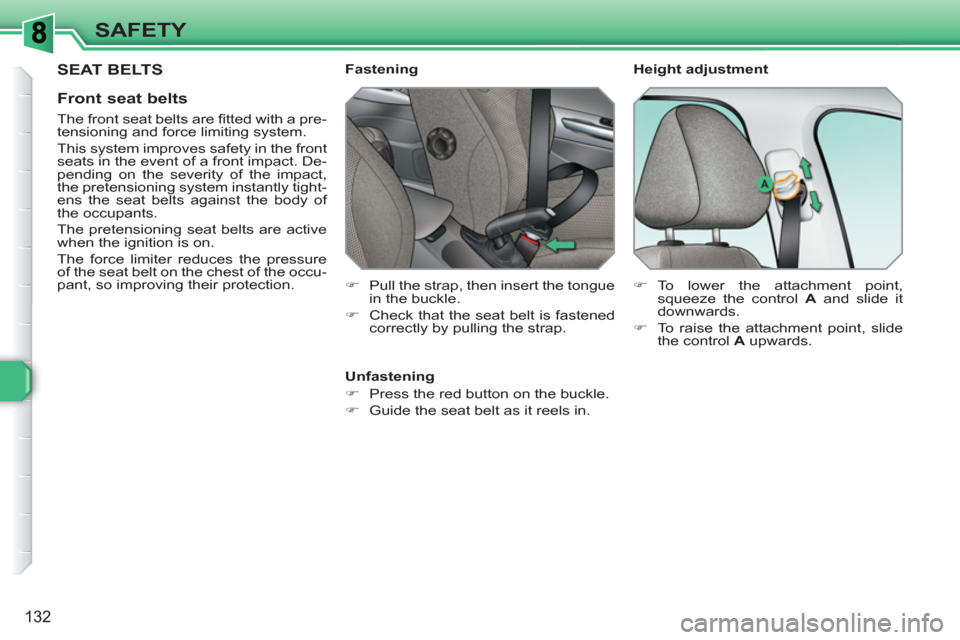
132
SAFETY
SEAT BELTS
Front seat belts
The front seat belts are fi tted with a pre-
tensioning and force limiting system.
This system improves safety in the front
seats in the event of a front impact. De-
pending on the severity of the impact,
the pretensioning system instantly tight-
ens the seat belts against the body of
the occupants.
The pretensioning seat belts are active
when the ignition is on.
The force limiter reduces the pressure
of the seat belt on the chest of the occu-
pant, so improving their protection.
Fastening
Unfastening
�)
Press the red button on the buckle.
�)
Guide the seat belt as it reels in.
Height adjustment
�)
Pull the strap, then insert the tongue
in the buckle.
�)
Check that the seat belt is fastened
correctly by pulling the strap.
�)
To lower the attachment point,
squeeze the control A
and slide it
downwards.
�)
To raise the attachment point, slide
the control A
upwards.
Page 135 of 336
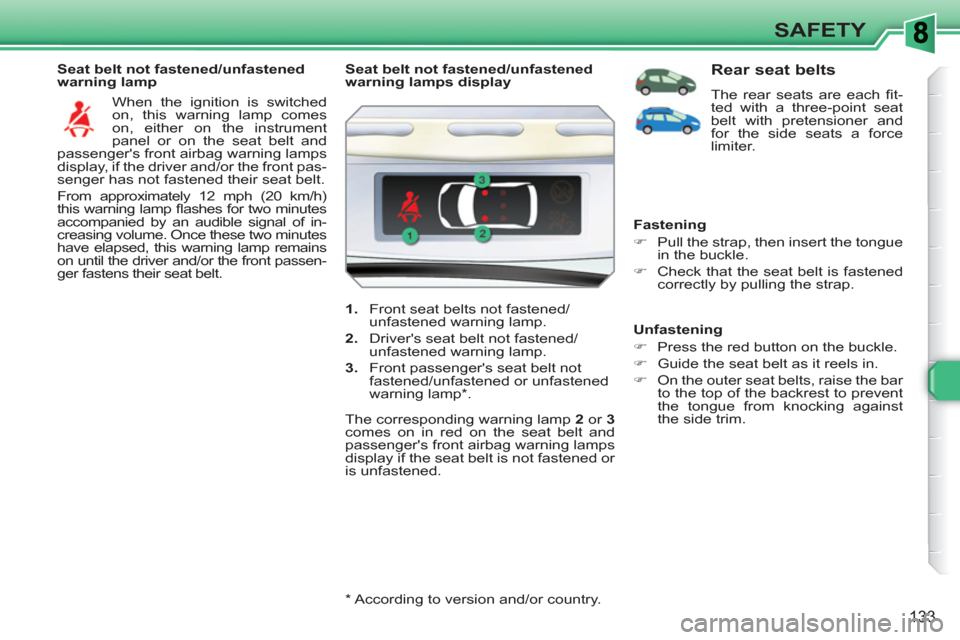
133
SAFETY
Seat belt not fastened/unfastened
warning lamp
When the ignition is switched
on, this warning lamp comes
on, either on the instrument
panel or on the seat belt and
passenger's front airbag warning lamps
display, if the driver and/or the front pas-
senger has not fastened their seat belt.
From approximately 12 mph (20 km/h)
this warning lamp fl ashes for two minutes
accompanied by an audible signal of in-
creasing volume. Once these two minutes
have elapsed, this warning lamp remains
on until the driver and/or the front passen-
ger fastens their seat belt.
*
According to version and/or country.
Seat belt not fastened/unfastened
warning lamps display
1.
Front seat belts not fastened/
unfastened warning lamp.
2.
Driver's seat belt not fastened/
unfastened warning lamp.
3.
Front passenger's seat belt not
fastened/unfastened or unfastened
warning lamp * .
The corresponding warning lamp 2
or 3
comes on in red on the seat belt and
passenger's front airbag warning lamps
display if the seat belt is not fastened or
is unfastened.
Rear seat belts
The rear seats are each fi t-
ted with a three-point seat
belt with pretensioner and
for the side seats a force
limiter.
Fastening
�)
Pull the strap, then insert the tongue
in the buckle.
�)
Check that the seat belt is fastened
correctly by pulling the strap.
Unfastening
�)
Press the red button on the buckle.
�)
Guide the seat belt as it reels in.
�)
On the outer seat belts, raise the bar
to the top of the backrest to prevent
the tongue from knocking against
the side trim.